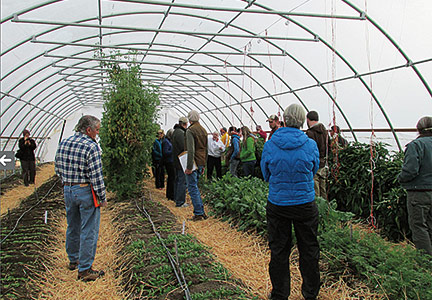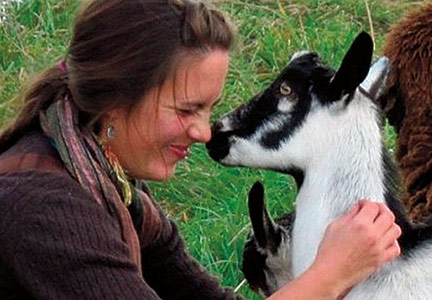In 1974, a group of Washington farmers, gardeners, and concerned citizens formed one of the nation’s first organized efforts for sustainable agriculture.
It was in the midst of a burgeoning back-to-the-land movement, and not long after the founding of Earth Day. The time was ripe for Washington, its farmers, consumers, and researchers to change agriculture.
On his way home from a Spokane conference on “Agriculture for a Small Planet,” author and activist Wendell Berry started a letter that would catalyze the movement. He praised the thoughtful and knowledgeable group who had organized the event, and wondered if they might work together to shape “a coherent vision for what is possible.”
“Good land use is going to come either by hard necessity or by some kind of teaching,” he wrote, encouraging them to seek “a better kind of agriculture.” They should reach out to farmers, farmworkers unions, urban consumer cooperatives, organic farming and small farm co-ops, and conservation and wilderness groups, he wrote, bringing together the “various branches of agricultural dissidence.”
Berry’s letter inspired several people to quickly pull together a meeting in Ellensburg. Nearly 800 farmers, workers, and consumers showed up, and a handful of WSU students and faculty came, too.
David Granatstein, now a sustainable agriculture specialist with WSU, had just finished his degree in environmental conservation at Cornell University and was driving across the country looking for work. He landed in Ellensburg just as the meeting was taking place. “I somehow heard there was a conference there on agriculture,” he says. The event was “somewhat of a blur.” But he remembers workshops on farming, talk about forming an organic farming movement, and learning about a rural apprenticeship that landed him on a farm in the San Juan Islands.
Woody Deryckx, a former WSU student who was farming near Palouse, and his wife Becky and friend Michael Pilarski, had joined up with Gigi Coe and Mark Musick to plan the Ellensburg event. And the Deryckxes came up with “Tilth,” a Middle English word meaning cultivated land, but a word that would come to represent a broad movement to create and support a more sustainable agriculture.
Today, the effort that is Tilth has spread throughout the West into California, Oregon, and Idaho. With teaching and support as its initial missions, it has produced books, newsletters, classes, and conferences and buoyed, and sometimes driven, the development of sustainable and organic agriculture in the region.
As Tilth evolved, so did research at WSU into organic and sustainable agriculture. Robert Papendick, a WSU-based USDA soil scientist, led a national study in the late 1970s to look at organic farming across the country and co-authored a seminal report acknowledging the viability of organic farming. At the same time Dave Bezdicek, a WSU soil microbiologist, organized the first organic farming symposium at the American Society of Agronomy’s national meetings.
By the 1980s, more WSU faculty and students were incorporating organic agriculture in their research. Their early efforts have today led to the WSU Center for Sustaining Agriculture and Natural Resources, a Small Farms Program, and the nation’s first organic agriculture major.
“There was always somebody at WSU who was playing some role in terms of national leadership with the organic movement,” says Matthew Canfield, a New York University doctoral student writing his dissertation on the sustainable food movement in Washington. A National Science Foundation grant is funding his fieldwork in the state. Besides digging into the WSU archives where the early Tilth records reside, he is interviewing the people who started and shaped the effort.
“Dave Bezdicek was ‘the’ WSU researcher of the Tilth movement,” says Canfield. “With his work and Papendick’s, the scientific legitimization to organic agriculture gave the movement some of its key resources.”
In 1977, Tilth in Washington became a non-profit alliance of growers. It focused on cooperative production and marketing, and developed a state-wide set of organic standards. “We now have one of the best ones in the country,” says Granatstein.
Even with limited resources, the organization has succeeded thanks to the work of volunteers, says Granatstein. One in particular, Anne Schwartz ’78, a Skagit Valley farmer, took a major role very early. “She sort of busts on to the scene,” says Canfield. “You can see it in the minutes. First she’s attending. Then within like three meetings she’s facilitating. Then she’s driving it.” Schwartz served as president of the Tilth Producers for a number of years and has long been a champion of organic research at WSU.
In 1984 Oregon Tilth split off and became its own nonprofit, creating the country’s first organic certification program. “Tilth started out as a movement,” says Canfield. “But then it gave birth to several organizations.” Today, Washington’s chapters include Snoqualmie Valley Tilth, Spokane Tilth, and the Tilth Producers of Washington, which offers farm walks, classes in subjects like urban goat keeping and on-farm composting, and resources for supporting the business of farming. Seattle Tilth has an urban slant, teaching adults and children in the city about organic gardening and urban ecology.
That all this has happened in Washington fascinates Canfield. “Washington state has been one of the national leaders in the sustainable food movement,” he says. Our state was a prime location because of diversity of what is grown here as well as the political landscape and consumer interest. In the 1970s waves of people from around the country came to Washington looking for a place to “live their values” and finding a sense of possibility that they couldn’t in other places, he says.
“There were lots of different farming movements in the United States,” says Canfield. “But none of them had this vision of transforming agriculture. I think Washington will be a really important role model for the rest of the country.”


